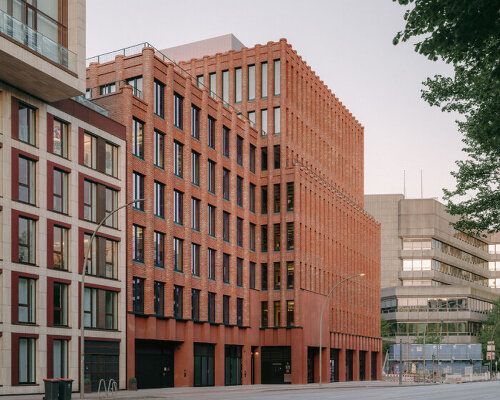christ & gantenbein rework hamburg’s Material heritage
A rhythmic facade of red clay bricks defines Christ & Gantenbein’s mixed-use office and residential complex in central Hamburg, Germany. Positioned between the city’s Nikolaifleet canal and the broad avenue of Willy-Brandt-Strasse, the project responds to its layered context by referencing the city’s industrial heritage through a distinctly contemporary lens.
Defined by its rhythmic pilasters and sculptural massing, the building mediates between the encompassing low-rise Fleet houses and the larger-scale developments. Across its elevations, semi-circular brick columns bring both visual weight and material texture, echoing the city’s 20th-century tradition of Brick Expressionism. With varied recesses and stepped rooflines, the building also reflects the irregular geometry of the site and subtly reinforces key urban axes leading toward the harbor and nearby square.
all images © Simon Menges
the mixed-use complex wraps in local red brick
Christ & Gantenbein’s project is distinguished by its attention to brick as both a structural and symbolic material. Locally sourced and hand-produced bricks by Rusch, the last surviving ring kiln brickyard in the region, bring both color and craft to the facade, while embedding regional memory into the contemporary architectural language.
The Swiss firm has also introduced green-painted window frames that offer a subtle contrast to the red bricks, introducing a contemporary palette to the historic texture. Elsewhere, the load-bearing structure — anchored by deep poles to accommodate the waterside setting — balances tectonic clarity with a sensitivity to site-specific conditions.
Christ & Gantenbein completes mixed-use office and residential complex in central Hamburg
A dual program With varied recesses and stepped rooflines
Designed to accommodate both office and residential programs, the development comprises two distinct volumes, with a taller corner element facing the bridge positioned with a more restrained canal-facing wing. While the office facade adopts a denser rhythm, the residential bays are wider, offering more privacy and sunlight. A restaurant and public spaces activate the ground floor, fostering connection between the canal and the adjacent square.
Within, Christ & Gantenbein has organized the programs for flexibility. The office floors can be subdivided freely, benefitting from natural light on multiple sides, while residential units, oriented south over the water, benefit from a quieter aspect and open views. Two dedicated entrances — one for residents and one for workers — also reinforce the programmatic split and enhance legibility from the street.
the project responds eferences the city’s industrial heritage through a distinctly contemporary lens
a rhythmic facade of red clay bricks
defined by its rhythmic pilasters and sculptural massing
the firm introduces green-painted window frames that offer a subtle contrast to the red bricks
with varied recesses and stepped rooflines, the building also reflects the irregular geometry of the site
the load-bearing structure balances tectonic clarity with a sensitivity to site-specific conditions
project info:
name: Willy Brandt Strasse mixed-use complex
architect: Christ & Gantenbein | @christgantenbein
location: Hamburg, Germany
The post semi-circular brick columns clad christ & gantenbein’s hamburg complex in rhythmic pattern appeared first on designboom | architecture & design magazine.

